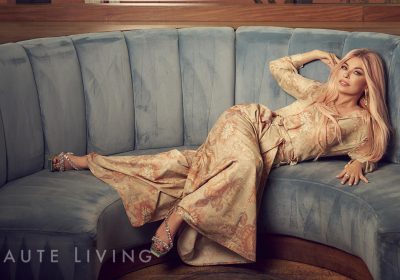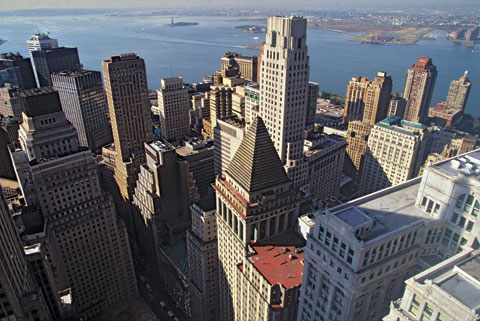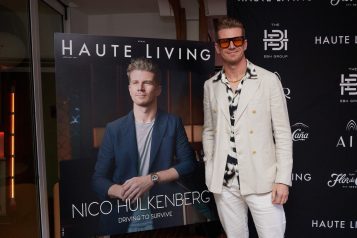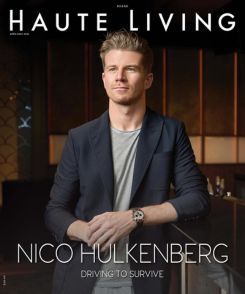You can forget all your worries about the suffering downtown district. Lower Manhattan is on the rise once again, making strides to become the next “it” neighborhood in New York City.
By Stephanie Wilson
“Over the past 10 years, Lower Manhattan has transformed itself from a business district to a vibrant, growing residential and mixed-use neighborhood.”
Tony Hatch, composer responsible for the classic “Downtown” hit, got it right when he penned the catchy lyrics to the classic tune sung by Petula Clark. Things are, indeed, great downtown in New York City. The neon lights are, indeed, pretty. How can you lose?
The horrible occurrences on 9/11, for one, remind us how we can lose. Before that date, the Financial District of Lower Manhattan had begun to see some residential growth, as well as growth in the luxury sectors, that was immediately halted. Today, the area has once again been revitalized, and business is booming in Lower Manhattan, although it is far from business as usual; it’s business as luxurious as it gets. This much is obvious from the influx of luxury retailers in the area, who finally realized that being close to the epicenter of the world’s wealth-aka Wall Street-might be good for business.
BMW was the first luxury brand that was ahead of that learning curve. In June 2005, BMW of Manhattan opened a showroom for new BMW car sales at 67 Wall Street, becoming part of a select group of retailers that was taking part in investing in the economic redevelopment of the downtown area. “We also wanted to add a level of confidence to members of the financial community,” explains Nicole Caruso, marketing and communications manager, BMW of Manhattan, Inc. The success of the retail center was immediate: Brokers now only had to walk downstairs to spend some of their bonuses.
After seeing the soaring sales of brands like BMW, developers started taking note of the area as well. Prior to 9/11, Tony Goldman’s Goldman Properties had already been working on creating “The Village of Wall Street,” the development of which had been hindered by the tragedy. But the growth has since gotten back on track, and Lower Manhattan is becoming the epicenter of chic.
“Over the past 10 years, Lower Manhattan has transformed itself from a business district to a vibrant, growing residential and mixed-use neighborhood,” says World Trade Center Properties Senior Vice President Janno Lieber.
But it isn’t the influx of normal residential buildings that interests us, but rather the caliber of said buildings. From Cipriani Downtown and Downtown by Philippe Starck to André Balazs’ William Beaver House and W New York-Downtown, the brands that are taking root in the Financial District can be called nothing less than über luxe, providing the ideal resting places for the Wall Street rangers who think that a $10 million yearly bonus is small time.
One of the premiere developments, Cipriani Club Residences, is located in the midst of the trading at 55 Wall Street-the former home of the stock exchange-further cementing the idea that Wall Street isn’t just for trading anymore. It’s for living with a sommelier on call and with a dedicated staff who can turn down your linens every night. It’s for those who work hard and earn the good life. The Residences, which have garnered endless press attention-from this rag and others-has been joined by some other heavy hitters in the neighborhood.
The former headquarters of J.P. Morgan is being transformed into Downtown by Philippe Starck, aka 15 Broad Street. The sold-out luxury condominium is being heralded as the place to go for “imaginative living,” and with Starck behind the drawing board, anything is possible. But Stark has also kept true to the building’s illustrious past, meticulously restoring the classic Louis XV-style chandelier that originally hung in the main banking room at J.P. Morgan. “The building offers elegance, intelligence, and surprise to people who are seeking something different, something new, yet something rooted in the beauty and history of Wall Street,” says Starck. “We have created an island of happiness where everything a resident needs can be found.”
The building also provides its residents a 5,000-square-foot roof park that looks out over New York Stock Exchange and Federal Hall. “Downtown by Philippe Starck has pioneered luxury residential development on Wall Street, but also redefined the definition of luxury,” says Leviev Boymelgreen, developer of the project. And they certainly redefined luxury for the neighborhood: Hermès established roots on the ground floor, citing the location as the natural progression for the brand.
“We were always interested in a second location in the city but weren’t quite sure yet where the right place would be,” says Hermès USA’s Robert Chavez. “Then we saw the conversion of old office buildings to condominiums. We had known there was a built-in business client base with thousands of thousands of people that come into downtown. And we knew there was a tourist factor there, between the South Street Seaport, the Stock Exchange, and other points of interest. And this, the conversion to condominiums, was the third point of the triangle that caught our interest. Suddenly, it dawned on us that you are going to have a residential community that is going to keep growing. And so we decided that we wanted to be at the forefront of that redevelopment, and we wanted to make our imprint and support that redevelopment.”
Certainly, having such an established name as Hermès investing in the area piqued the interest of other high-end stores. The reputable Tiffany & Co. opened a location at 37 Wall Street this past October in a 25-story Beaux Arts building originally designed as the headquarters for the Trust Company of America. The building is heralded as being one of America’s original skyscrapers. And, considering that Tiffany’s first store opened on Lower Broadway in 1837, this establishment represents a return to the company’s illustrious roots. “Now we’re coming home to join in the renewed spirit of Lower Manhattan with a contemporary store design that embraces the future and honors the past symbolized by the historic architecture of 37 Wall Street,” says Beth O. Canavan, executive vice president of Tiffany & Co.
The opening of these two venerable brands downtown has started a trend in luxury retailers, and for good reason. “The Financial District is home to the world’s wealthiest firms and biggest bonuses,” explains Faith Hope Consolo, chairman of retail leasing and sales at Prudential Douglas Eliman, which makes her the city’s leading expert on luxury retailers. “With the influx of luxury retail-such as the iconic Tiffany’s-money is now being spent where it’s made!”
And that same money is being invested into residences at the famed W at 123 Washington Street, which is the sixth New York outpost for the world-renowned brand, just one block from the site of the new Freedom Tower. “W is deeply connected to Manhattan and we’re proud to be a part of this important project to revitalize this part of the City,” says Ross Klein, president of Starwood’s Luxury Brands Group. “W New York-Downtown will create a destination inside a destination, adding substance, style, and luxury to Manhattan’s most anticipated new project.” Well, let’s be honest: one of the most anticipated new projects. Downtown has so much going on and going up, it’s nearly impossible to determine which should be crowned as “the best.”
But what can be said is that Downtown is, indeed, well on its way to becoming the shining beacon of luxury that the Clark song refers to, further evidenced by Armani/Casa designs at 20 Pine, the former headquarters of Chase Manhattan Bank. The building, once renovated, will include 409 luxury condominiums bathed in the luxuries synonymous with the Armani name. “Taking the building’s Deco period design and the rich history of the City’s Financial District as our points of departure, we wanted to create a space that reflected both a reserved, cultured sophistication as well as an elite, ultra-luxurious ambiance. Our greatest challenge was to reconcile the architectural monumentality of the original building’s scale with the desire for warm and inviting intimacy in the interior design spaces,” says Robert Triefus, executive vice president of communications for Giorgio Armani S.p.A.
With even more luxury retailers-such as Thomas Pink, Canali, Brioni, and Tumi-planned alongside high-end residences like the Setai and District, the financial capital of the world is well on its way to becoming the luxury capital of Manhattan.





















